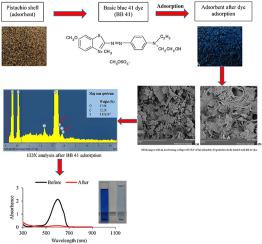Sustainable Chemistry and Pharmacy ( IF 6 ) Pub Date : 2020-04-28 , DOI: 10.1016/j.scp.2020.100254 İlknur Şentürk , Mazen Alzein

|
In present study, pistachio shell was used as an adsorbent to remove Basic blue 41 dye (BB 41) from textile wastewater effluents with a batch and a continuous system. The structure and characteristics of the pistachio shell were determined by pHpzc, FTIR spectroscopy, BET surface area and SEM-EDX analysis. A batch system was used to investigate the effects of dye concentration, pH, quantity and particle size of adsorbent, reaction duration, temperature and ion strength on dye removal performance were investigated. The error analysis methods were employed to get adsorption kinetics and the best-fitting isotherm models for adsorption of BB 41 dye. The results of modeling studies proved that Langmuir isotherms and pseudo-second-order kinetics the best represented adsorption kinetics and isotherm data. Present findings revealed that BB 41 removal was a feasible, spontaneous and endothermic process. Decreasing removal (%) rates were with increasing NaCl and SDS concentrations. After three cycles, regeneration efficiency was calculated as 65.39%. Continuous mode of operation was used for optimization of process parameters such as initial pollutant concentration, effluent flow rate and bed height. In continuous system, maximum adsorption capacity was identified as 41.77 mg/g. The Adams-Bohart, Thomas and Yoon-Nelson models were used to find of the best fitting model for experimental data of continuous mode of operation. Pistachio shell had yielded quite high adsorption of dye, thus it was also conduced that pistachio shell could effectively and reliably be utilized in treatment of wastewater effluents of textile industry containing Basic blue 41 textile dye.
中文翻译:

阿月浑子壳吸附剂对碱性蓝41的吸附去除-间歇和柱系统性能
在本研究中,开心果壳被用作吸附剂,以分批和连续的方式从纺织废水中去除碱性蓝41染料(BB 41)。阿月浑子壳的结构和特性由pH pzc确定,FTIR光谱,BET表面积和SEM-EDX分析。用批处理系统研究染料浓度,pH,吸附剂的数量和粒径,反应时间,温度和离子强度对染料去除性能的影响。利用误差分析方法获得了吸附动力学,并通过最佳拟合等温线模型对BB 41染料进行了吸附。建模研究结果证明,Langmuir等温线和拟二级动力学最能代表吸附动力学和等温线数据。目前的发现表明,去除BB 41是一个可行,自发和吸热的过程。随着NaCl和SDS浓度的增加,去除率(%)降低。经过三个循环后,再生效率为65.39%。连续操作模式用于优化工艺参数,例如初始污染物浓度,废水流速和床高。在连续系统中,最大吸附容量为41.77 mg / g。Adams-Bohart,Thomas和Yoon-Nelson模型被用来为连续操作模式的实验数据找到最佳拟合模型。开心果壳对染料的吸附非常高,因此也认为开心果壳可以有效,可靠地用于处理含碱性蓝41纺织染料的纺织工业废水。托马斯(Thomas)和尤恩·尼尔森(Yoon-Nelson)模型用于为连续操作模式的实验数据找到最佳拟合模型。开心果壳对染料的吸附非常高,因此也认为开心果壳可以有效,可靠地用于处理含碱性蓝41纺织染料的纺织工业废水。托马斯(Thomas)和尤恩·尼尔森(Yoon-Nelson)模型用于为连续操作模式的实验数据找到最佳拟合模型。开心果壳对染料的吸附非常高,因此也认为开心果壳可以有效,可靠地用于处理含碱性蓝41纺织染料的纺织工业废水。


























 京公网安备 11010802027423号
京公网安备 11010802027423号